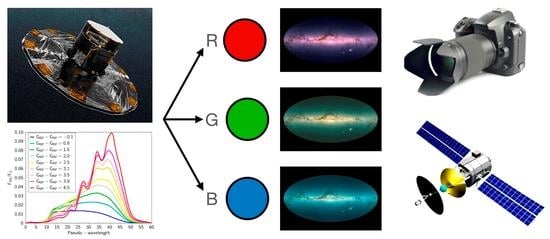Photometric Catalogue for Space and Ground Night-Time Remote-Sensing Calibration: RGB Synthetic Photometry from Gaia DR3 Spectrophotometry
Abstract
1. Introduction
2. RGB Catalogue Construction
3. Comparison with the C21 Sample
3.1. Number of Calibrated Sources
3.2. Source Characteristics
3.3. Magnitude Residuals
4. Validity of the C21 Polynomial Calibration
5. Accessing the 200 M Sample
- 1.
- Cone search in Gaia DR3 down to the pre-defined limiting magnitude, retrieving the following parameters: source_id, ra, dec, phot_g_mean_mag, phot_bp_mean_mag, phot_rp_mean_mag and phot_variable_flag.
- 2.
- Initial RGB magnitude estimation using the polynomial transformations given in Equations (2)–(4) by C21.
- 3.
- Retrieval of the RGB synthetic magnitudes for sources in the 200 M sample within the healpix level-8 tables enclosing the region of the sky defined in the initial cone search.
- 4.
- Cross-matching between the Gaia DR3 and the 200 M subsamples to identify sources with RGB synthetic magnitudes estimated from the XP low-resolution spectra.
- 5.
- Generation of the output files. In particular, two files (in CSV format) are generated: rgbloom_200m.csv, which contains the sources belonging to the 200 M sample with RGB synthetic magnitudes; and rgbloom_no200m.csv, which includes sources that do not belong to the 200 M sample. In this latter case, the RGB magnitudes provided in the file correspond to the estimates derived using the polynomial relationships in C21. It is important to remember (see Section 3) that these estimates are more uncertain than the new RGB values computed in this work and that they can be biased due to systematic effects introduced by interstellar extinction by exhibiting a colour outside the interval (where the C21 calibrations were computed) or by variability of the source.
- 6.
- Creation of a finding chart of the results (see the example in Figure 15 for the region around the Pleiades star cluster). The users of rgbloom should rely more strongly on the RGB estimates corresponding to sources belonging to the 200 M sample (labelled with red numbers in Figure 15) and make judicious use of the predictions that rely on the C21 polynomial calibration (labelled with black numbers in the same figure) as discussed in Section 4. Nevertheless, since the sky coverage of the 200 M sample is still not very good at certain high Galactic latitudes (see Figure 4), the RGB estimates from the C21 polynomial calibration may still be useful after discarding the sources with large interstellar extinction.
6. Conclusions
Author Contributions
Funding
Data Availability Statement
Acknowledgments
Conflicts of Interest
References
- Cardiel, N.; Zamorano, J.; Bará, S.; Sánchez de Miguel, A.; Cabello, C.; Gallego, J.; García, L.; González, R.; Izquierdo, J.; Pascual, S.; et al. Synthetic RGB photometry of bright stars: Definition of the standard photometric system and UCM library of spectrophotometric spectra. Mon. Not. R. Astron. Soc. 2021, 504, 3730–3748. [Google Scholar] [CrossRef]
- Cardiel, N.; Zamorano, J.; Carrasco, J.M.; Masana, E.; Bará, S.; González, R.; Izquierdo, J.; Pascual, S.; Sánchez de Miguel, A. RGB photometric calibration of 15 million Gaia stars. Mon. Not. R. Astron. Soc. 2021, 507, 318–329. [Google Scholar] [CrossRef]
- Sánchez de Miguel, A.; Zamorano, J.; Aubé, M.; Bennie, J.; Gallego, J.; Ocana, F.; Pettit, D.R.; Stefanov, W.L.; Gaston, K.J. Colour remote sensing of the impact of artificial light at night (II): Calibration of DSLR-based images from the International Space Station. Remote Sens. Environ. 2021, 264, 112611. [Google Scholar] [CrossRef]
- Fulbright, J.P.; Xiong, X. Suomi-NPP VIIRS day/night band calibration with stars. In Earth Observing Systems XX; SPIE: San Diego, CA, USA, 2015; Volume 9607, pp. 488–508. [Google Scholar]
- Wilson, T.; Xiong, X. Intercomparison of the SNPP and NOAA-20 VIIRS DNB high-gain stage using observations of bright stars. IEEE Trans. Geosci. Remote Sens. 2020, 58, 8038–8045. [Google Scholar] [CrossRef]
- Jiang, J.; Liu, D.; Gu, J.; Süsstrunk, S. What is the space of spectral sensitivity functions for digital color cameras? In Proceedings of the 2013 IEEE Workshop on Applications of Computer Vision (WACV), Clearwater Beach, FL, USA, 15–17 January 2013; pp. 168–179. [Google Scholar] [CrossRef]
- Hoffleit, D. Catalogue of Bright Stars; Yale University Observatory: New Haven, CT, USA, 1964. [Google Scholar]
- Gaia Collaboration; Brown, A.G.A.; Vallenari, A.; Prusti, T.; de Bruijne, J.H.J.; Babusiaux, C.; Biermann, M.; Creevey, O.L.; Evans, D.W.; Eyer, L.; et al. Gaia Early Data Release 3. Summary of the contents and survey properties. Astron. Astrophys. 2021, 649, A1. [Google Scholar] [CrossRef]
- Riello, M.; De Angeli, F.; Evans, D.W.; Montegriffo, P.; Carrasco, J.M.; Busso, G.; Palaversa, L.; Burgess, P.W.; Diener, C.; Davidson, M.; et al. Gaia Early Data Release 3. Photometric content and validation. Astron. Astrophys. 2021, 649, A3. [Google Scholar] [CrossRef]
- Carrasco, J.M.; Weiler, M.; Jordi, C.; Fabricius, C.; De Angeli, F.; Evans, D.W.; van Leeuwen, F.; Riello, M.; Montegriffo, P. Internal calibration of Gaia BP/RP low-resolution spectra. Astron. Astrophys. 2021, 652, A86. [Google Scholar] [CrossRef]
- De Angeli, F.; Weiler, M.; Montegriffo, P.; Evans, D.W.; Riello, M.; Andrae, R.; Carrasco, J.M.; Busso, G.; Burgess, P.W.; Cacciari, C.; et al. Gaia Data Release 3: Processing and validation of BP/RP low-resolution spectral data. arXiv 2022, arXiv:2206.06143. [Google Scholar] [CrossRef]
- Montegriffo, P.; De Angeli, F.; Andrae, R.; Riello, M.; Pancino, E.; Sanna, N.; Bellazzini, M.; Evans, D.W.; Carrasco, J.M.; Sordo, R.; et al. Gaia Data Release 3: External calibration of BP/RP low-resolution spectroscopic data. arXiv 2022, arXiv:2206.06205. [Google Scholar] [CrossRef]
- Gaia Collaboration; Vallenari, A.; Brown, A.G.A.; Prusti, T.; de Bruijne, J.H.J.; Arenou, F.; Babusiaux, C.; Biermann, M.; Creevey, O.L.; Ducourant, C.; et al. Gaia Data Release 3: Summary of the content and survey properties. arXiv 2022, arXiv:2208.00211. [Google Scholar]
- Gaia Collaboration; Montegriffo, P.; Bellazzini, M.; De Angeli, F.; Andrae, R.; Barstow, M.A.; Bossini, D.; Bragaglia, A.; Burgess, P.W.; Cacciari, C.; et al. Gaia Data Release 3: The Galaxy in your preferred colours. Synthetic photometry from Gaia low-resolution spectra. arXiv 2022, arXiv:2206.06215. [Google Scholar] [CrossRef]
- Gaia Collaboration; Prusti, T.; de Bruijne, J.H.J.; Brown, A.G.A.; Vallenari, A.; Babusiaux, C.; Bailer-Jones, C.A.L.; Bastian, U.; Biermann, M.; Evans, D.W.; et al. The Gaia mission. Astron. Astrophys. 2016, 595, A1. [Google Scholar] [CrossRef]
- Weiler, M.; Carrasco, J.M.; Fabricius, C.; Jordi, C. Analysing spectral lines in Gaia low-resolution spectra. Astron. Astrophys. 2023, 671, A52. [Google Scholar] [CrossRef]
- Carrasco, J.M.; Weiler, M.; Jordi, C.; Fabricius, C. Gaia, an all-sky survey for standard photometry. In Highlights on Spanish Astrophysics IX; Arribas, S., Alonso-Herrero, A., Figueras, F., Hernández-Monteagudo, C., Sánchez-Lavega, A., Pérez-Hoyos, S., Eds.; Spanish Astronomical Society: Bilbao, Spain, 2017; pp. 622–627. [Google Scholar]
- Weiler, M.; Carrasco, J.M.; Fabricius, C.; Jordi, C. Spectrophotometric calibration of low-resolution spectra. Astron. Astrophys. 2020, 637, A85. [Google Scholar] [CrossRef]
- Fukugita, M.; Ichikawa, T.; Gunn, J.E.; Doi, M.; Shimasaku, K.; Schneider, D.P. The Sloan Digital Sky Survey Photometric System. Astron. J. 1996, 111, 1748. [Google Scholar] [CrossRef]
- Bessell, M.S. Standard Photometric Systems. Annu. Rev. Astron. Astrophys. 2005, 43, 293–336. [Google Scholar] [CrossRef]
- Sirianni, M.; Jee, M.J.; Benítez, N.; Blakeslee, J.P.; Martel, A.R.; Meurer, G.; Clampin, M.; De Marchi, G.; Ford, H.C.; Gilliland, R.; et al. The Photometric Performance and Calibration of the Hubble Space Telescope Advanced Camera for Surveys. Publ. Astron. Soc. Pac. 2005, 117, 1049–1112. [Google Scholar] [CrossRef]
- Crowley, C.; Kohley, R.; Hambly, N.C.; Davidson, M.; Abreu, A.; van Leeuwen, F.; Fabricius, C.; Seabroke, G.; de Bruijne, J.H.J.; Short, A.; et al. Gaia Data Release 1. On-orbit performance of the Gaia CCDs at L2. Astron. Astrophys. 2016, 595, A6. [Google Scholar] [CrossRef]
- Sánchez de Miguel, A.; Aubé, M.; Zamorano, J.; Kocifaj, M.; Roby, J.; Tapia, C. Sky Quality Meter measurements in a colour-changing world. Mon. Not. R. Astron. Soc. 2017, 467, 2966–2979. [Google Scholar] [CrossRef]
- Pérez, F.; Granger, B.E. IPython: A System for Interactive Scientific Computing. Comput. Sci. Eng. 2007, 9, 21–29. [Google Scholar] [CrossRef]
- Astropy Collaboration; Robitaille, T.P.; Tollerud, E.J.; Greenfield, P.; Droettboom, M.; Bray, E.; Aldcroft, T.; Davis, M.; Ginsburg, A.; Price-Whelan, A.M.; et al. Astropy: A community Python package for astronomy. Astron. Astrophys. 2013, 558, A33. [Google Scholar] [CrossRef]
- Astropy Collaboration; Price-Whelan, A.M.; Sipocz, B.M.; Günther, H.M.; Lim, P.L.; Crawford, S.M.; Conseil, S.; Shupe, D.L.; Craig, M.W.; Dencheva, N.; et al. The Astropy Project: Building an Open-science Project and Status of the v2.0 Core Package. Astron. J. 2018, 156, 123. [Google Scholar] [CrossRef]
- Harris, C.R.; Millman, K.J.; van der Walt, S.J.; Gommers, R.; Virtanen, P.; Cournapeau, D.; Wieser, E.; Taylor, J.; Berg, S.; Smith, N.J.; et al. Array programming with NumPy. Nature 2020, 585, 357–362. [Google Scholar] [CrossRef] [PubMed]
- Virtanen, P.; Gommers, R.; Oliphant, T.E.; Haberland, M.; Reddy, T.; Cournapeau, D.; Burovski, E.; Peterson, P.; Weckesser, W.; Bright, J.; et al. SciPy 1.0: Fundamental Algorithms for Scientific Computing in Python. Nat. Methods 2020, 17, 261–272. [Google Scholar] [CrossRef] [PubMed]
- Hunter, J.D. Matplotlib: A 2D Graphics Environment. Comput. Sci. Eng. 2007, 9, 90–95. [Google Scholar] [CrossRef]
- McKinney, W. Data Structures for Statistical Computing in Python. In Proceedings of the Ninth Python in Science Conference, Austin, TX, USA, 28 June–3 July 2010; van der Walt, S., Millman, J., Eds.; pp. 56–61. [Google Scholar] [CrossRef]
- Breddels, M.A.; Veljanoski, J. Vaex: Big data exploration in the era of Gaia. Astron. Astrophys. 2018, 618, A13. [Google Scholar] [CrossRef]
- Górski, K.M.; Hivon, E.; Banday, A.J.; Wandelt, B.D.; Hansen, F.K.; Reinecke, M.; Bartelmann, M. HEALPix: A Framework for High-Resolution Discretization and Fast Analysis of Data Distributed on the Sphere. Astrophys. J. 2005, 622, 759–771. [Google Scholar] [CrossRef]
- Zonca, A.; Singer, L.; Lenz, D.; Reinecke, M.; Rosset, C.; Hivon, E.; Gorski, K. healpy: Equal area pixelization and spherical harmonics transforms for data on the sphere in Python. J. Open Source Softw. 2019, 4, 1298. [Google Scholar] [CrossRef]
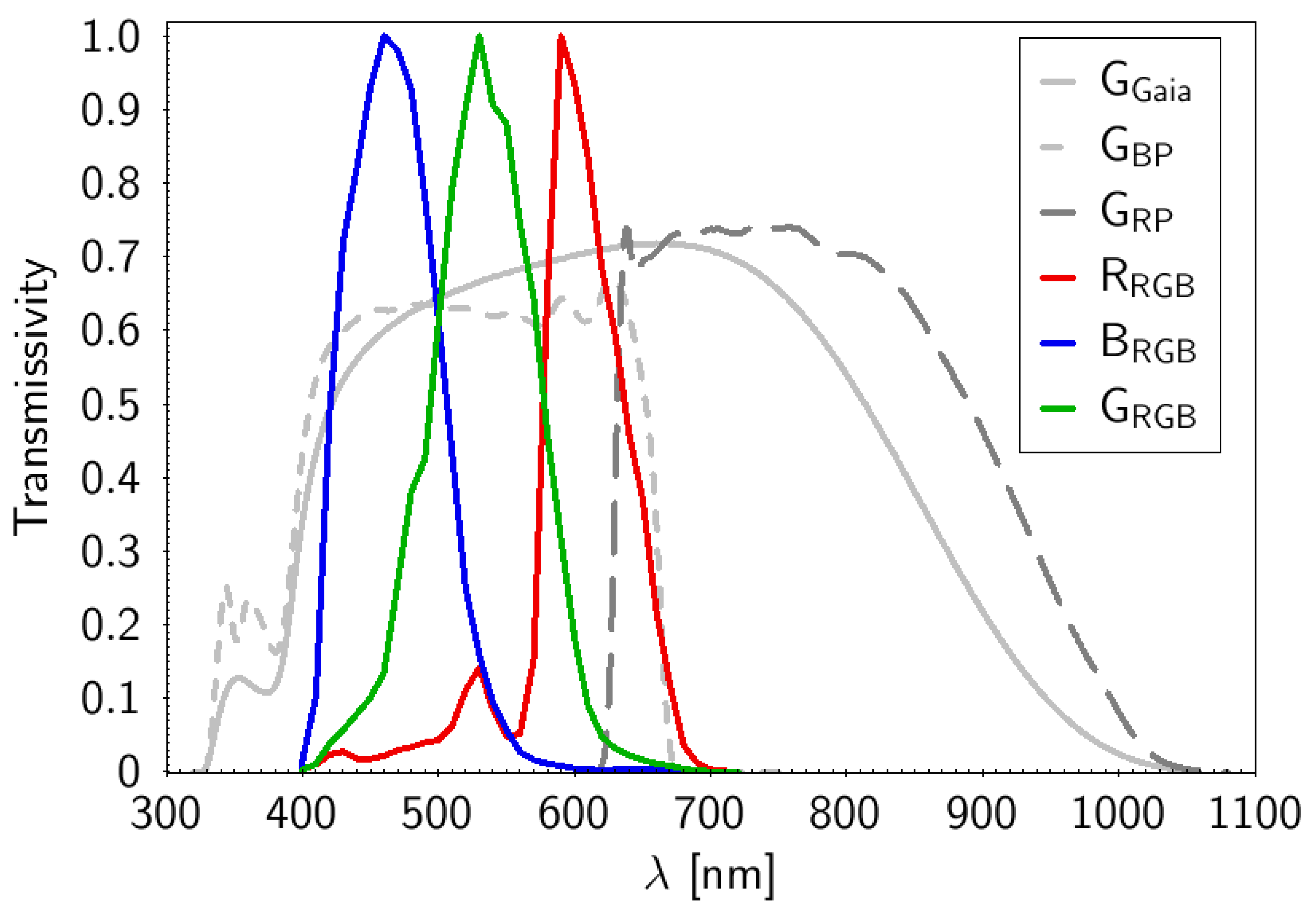
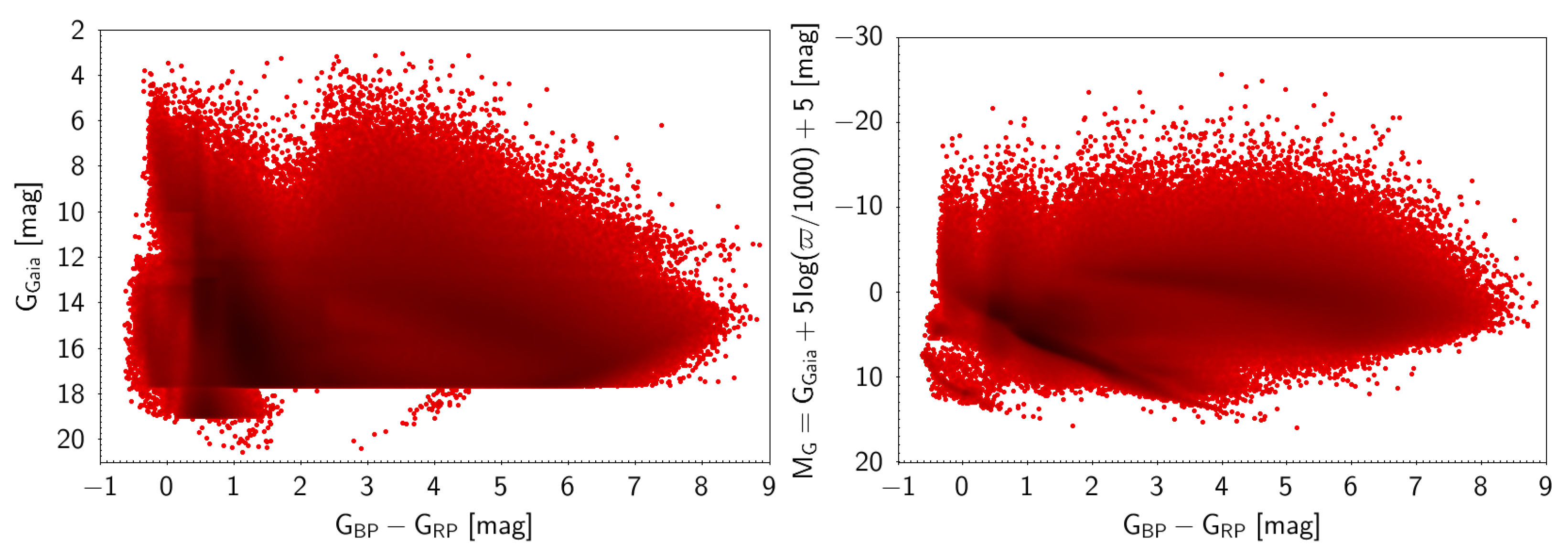
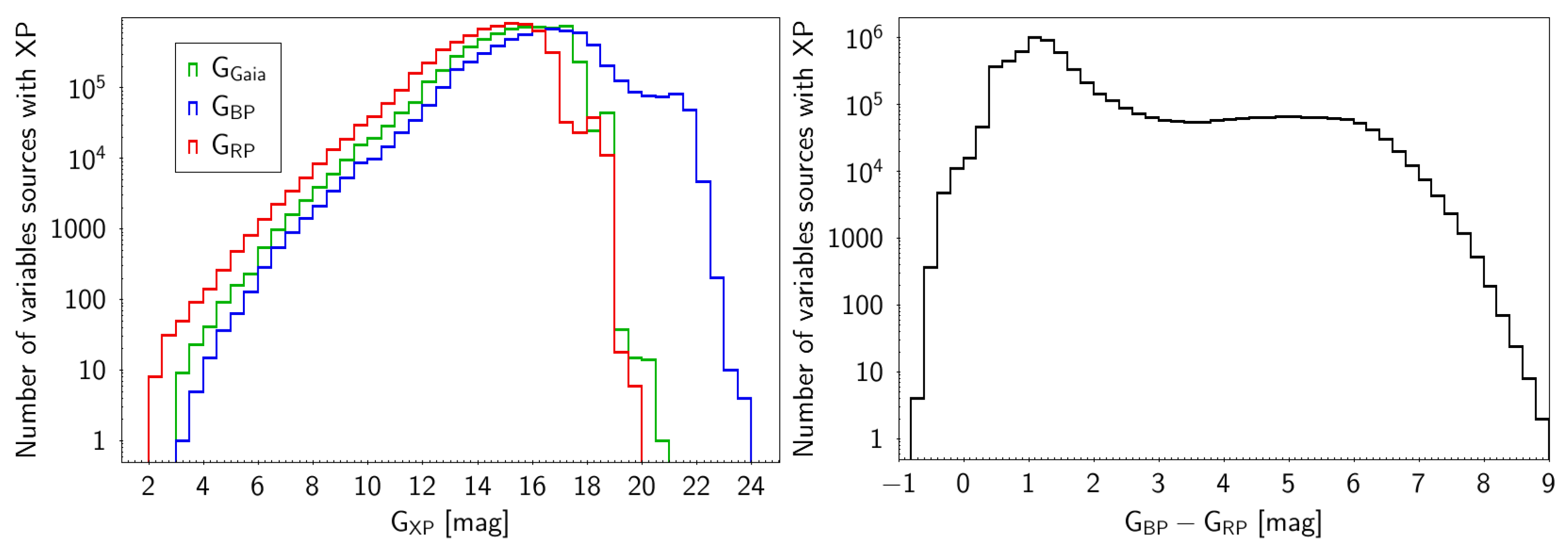
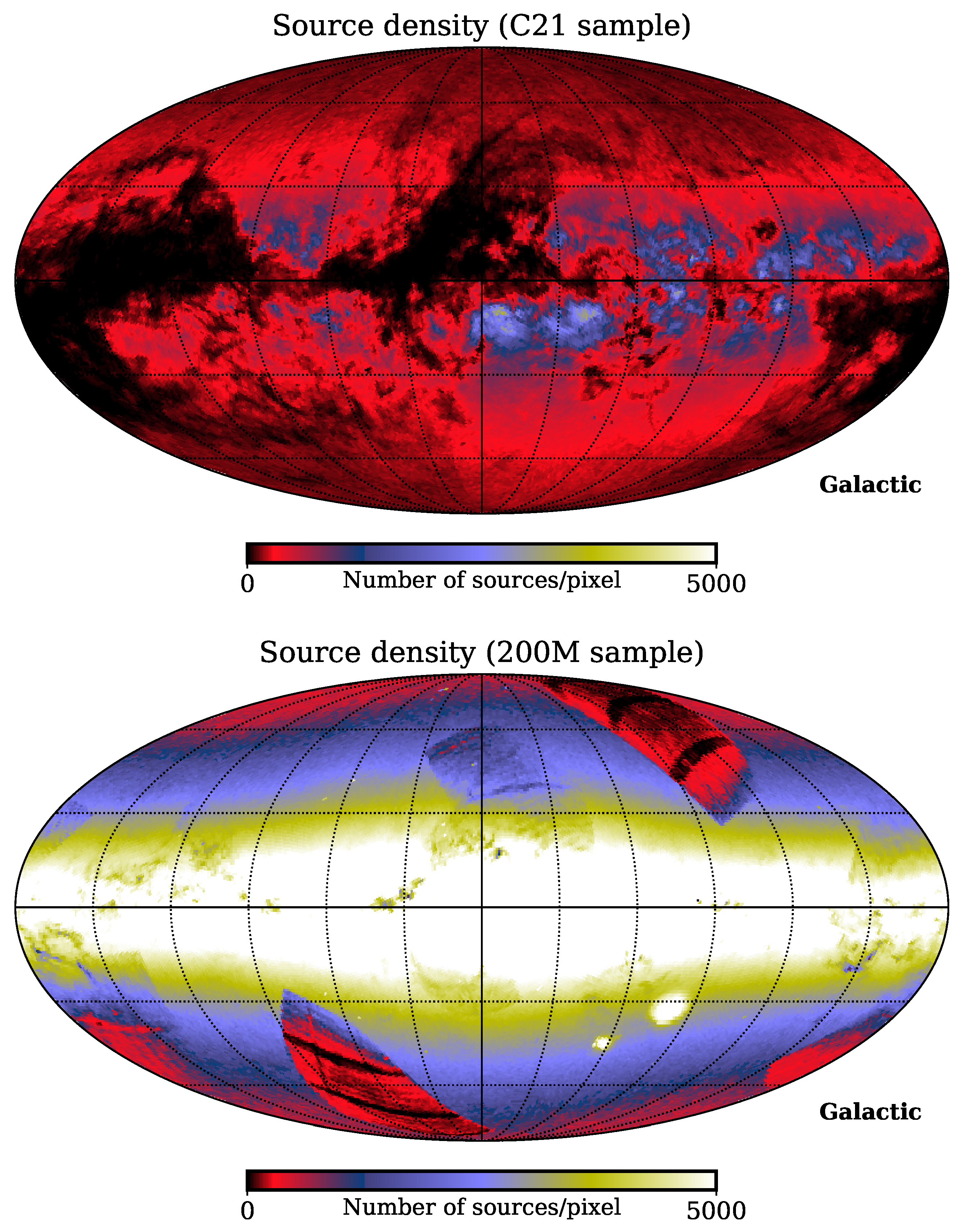
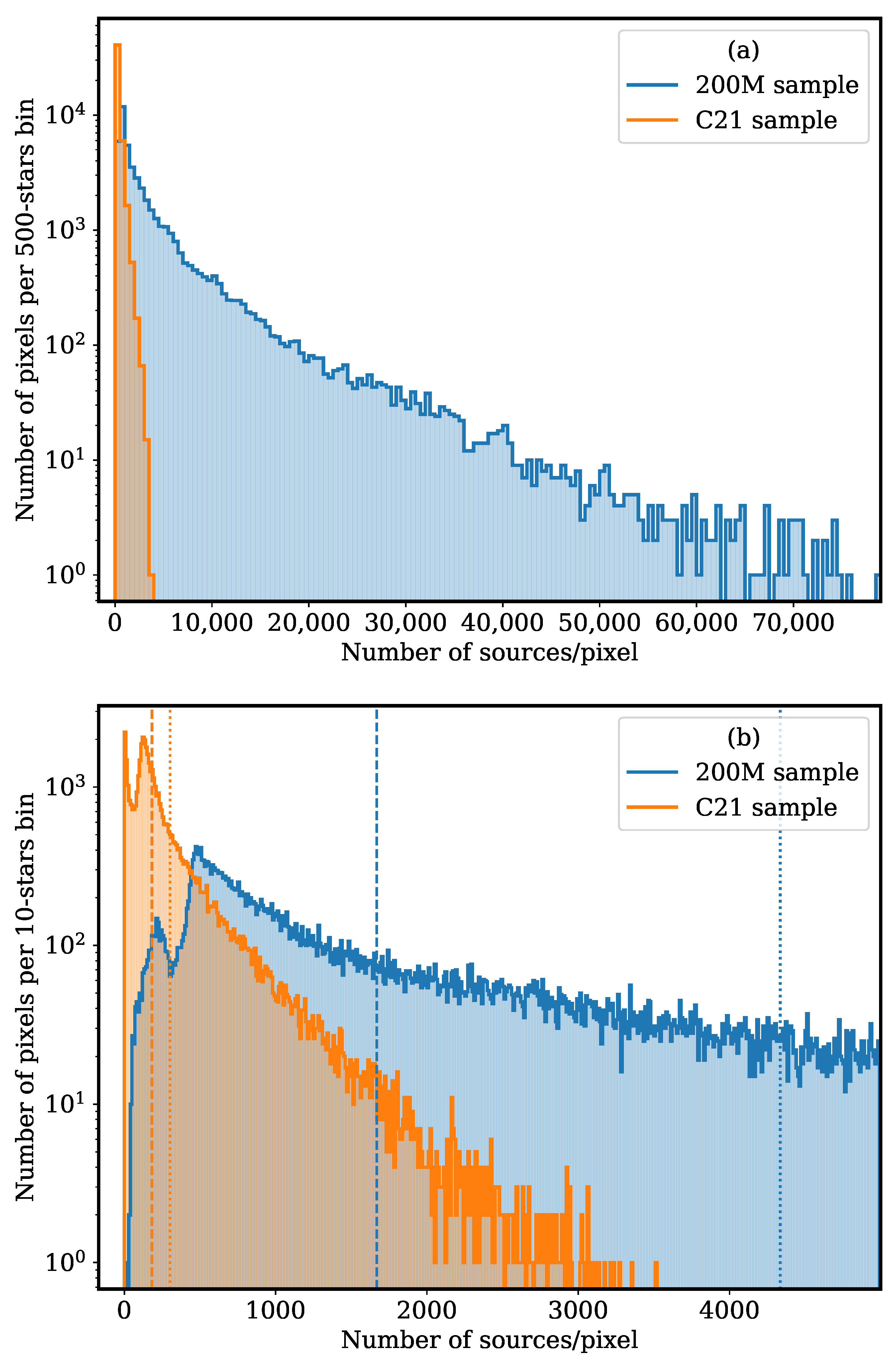
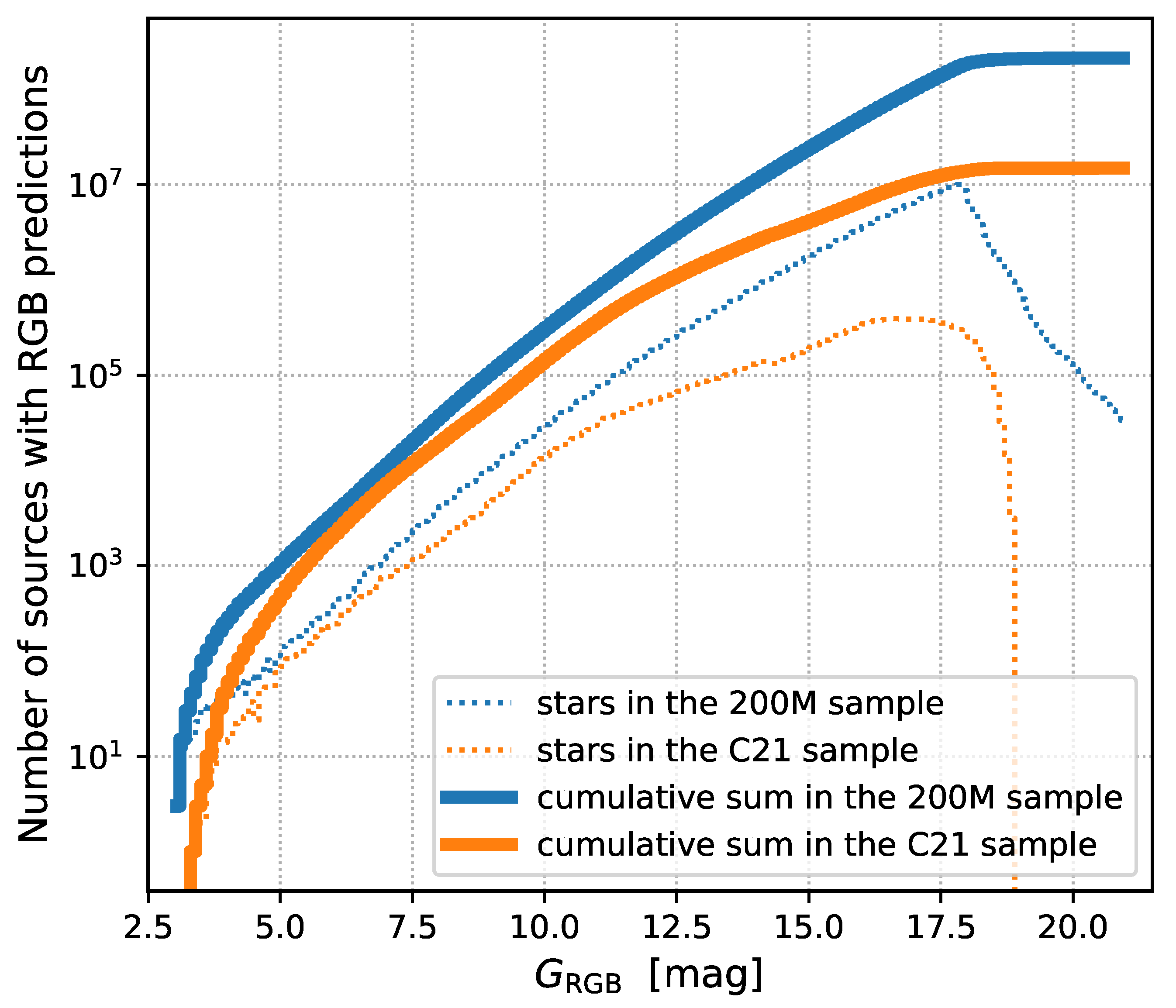
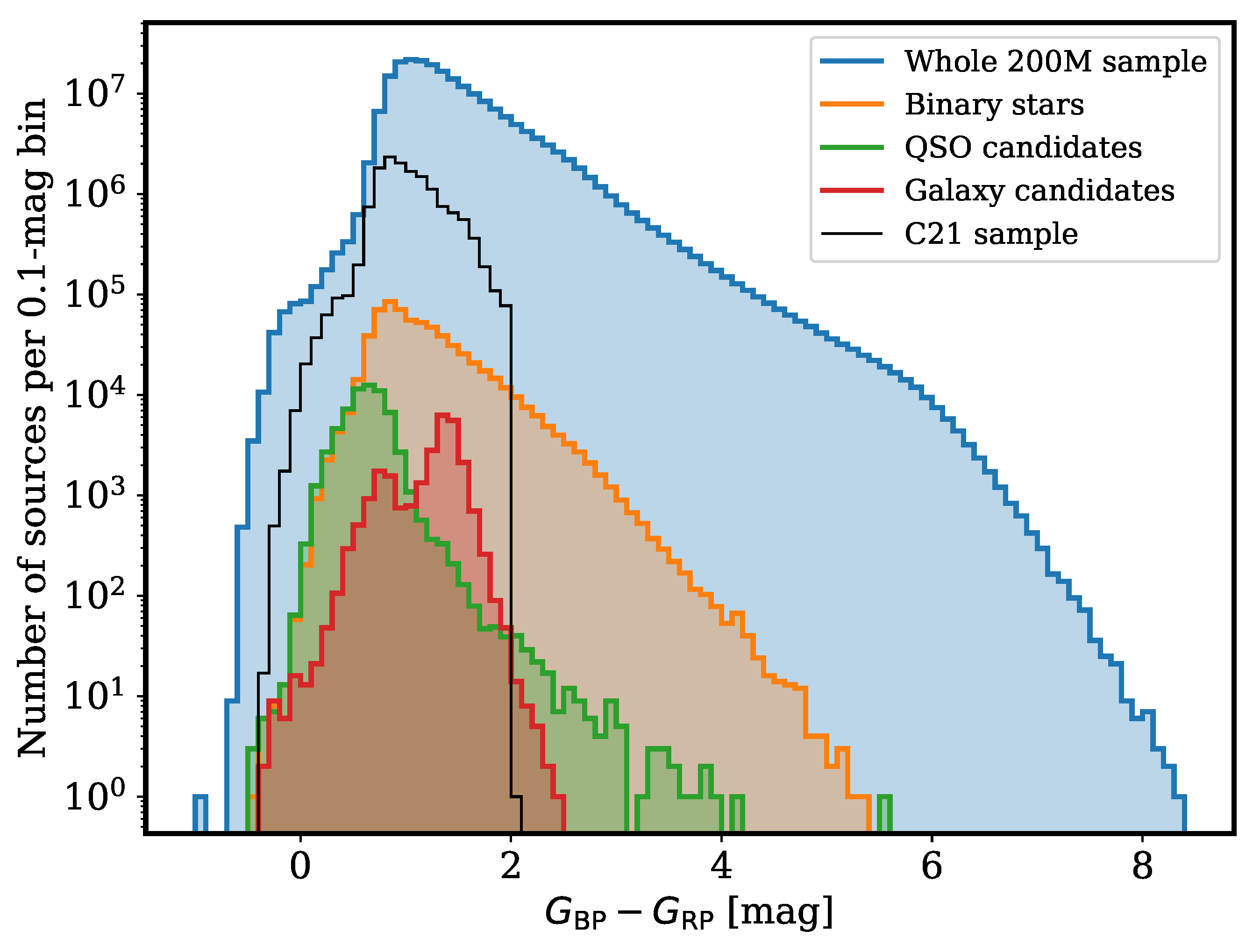
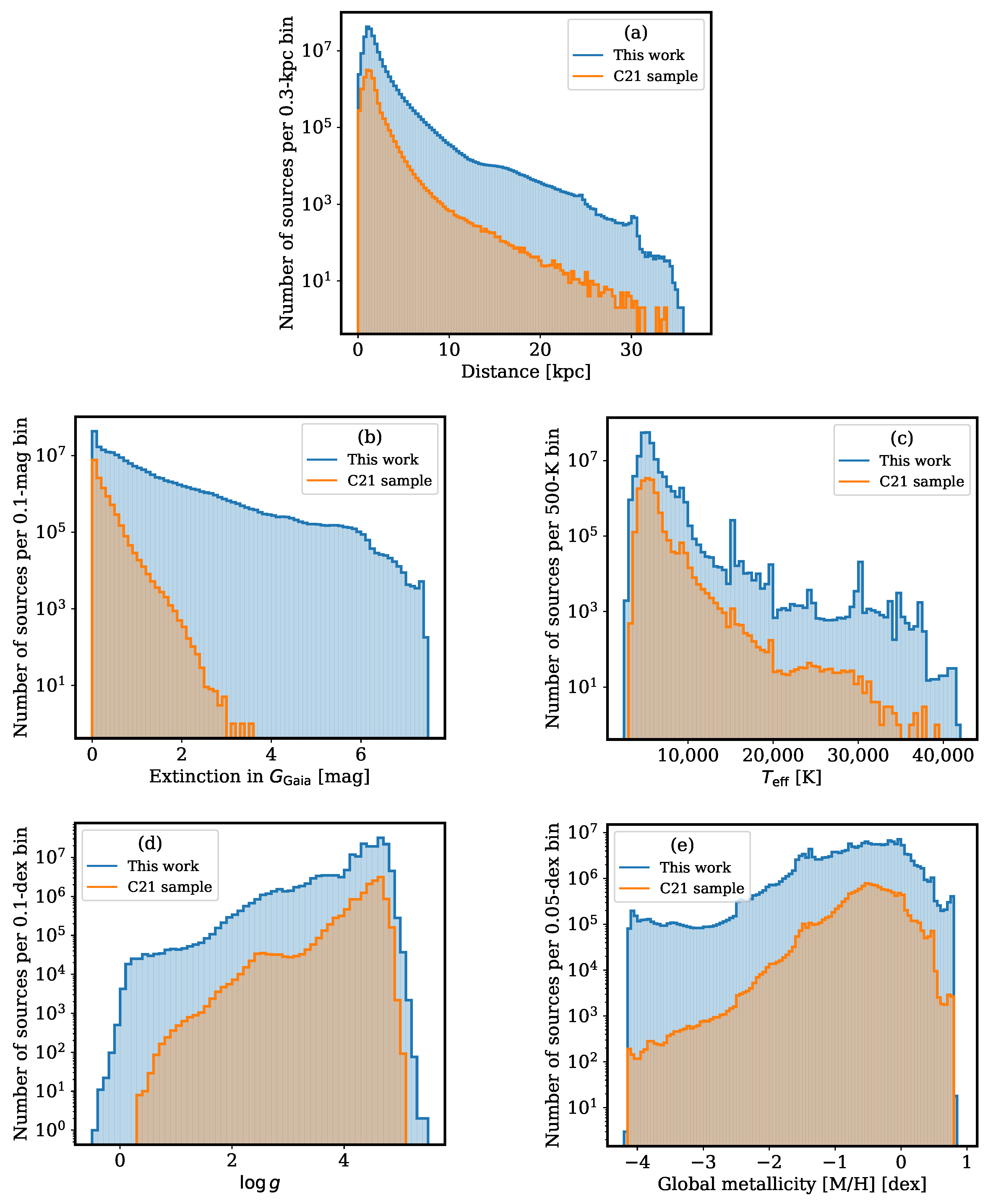
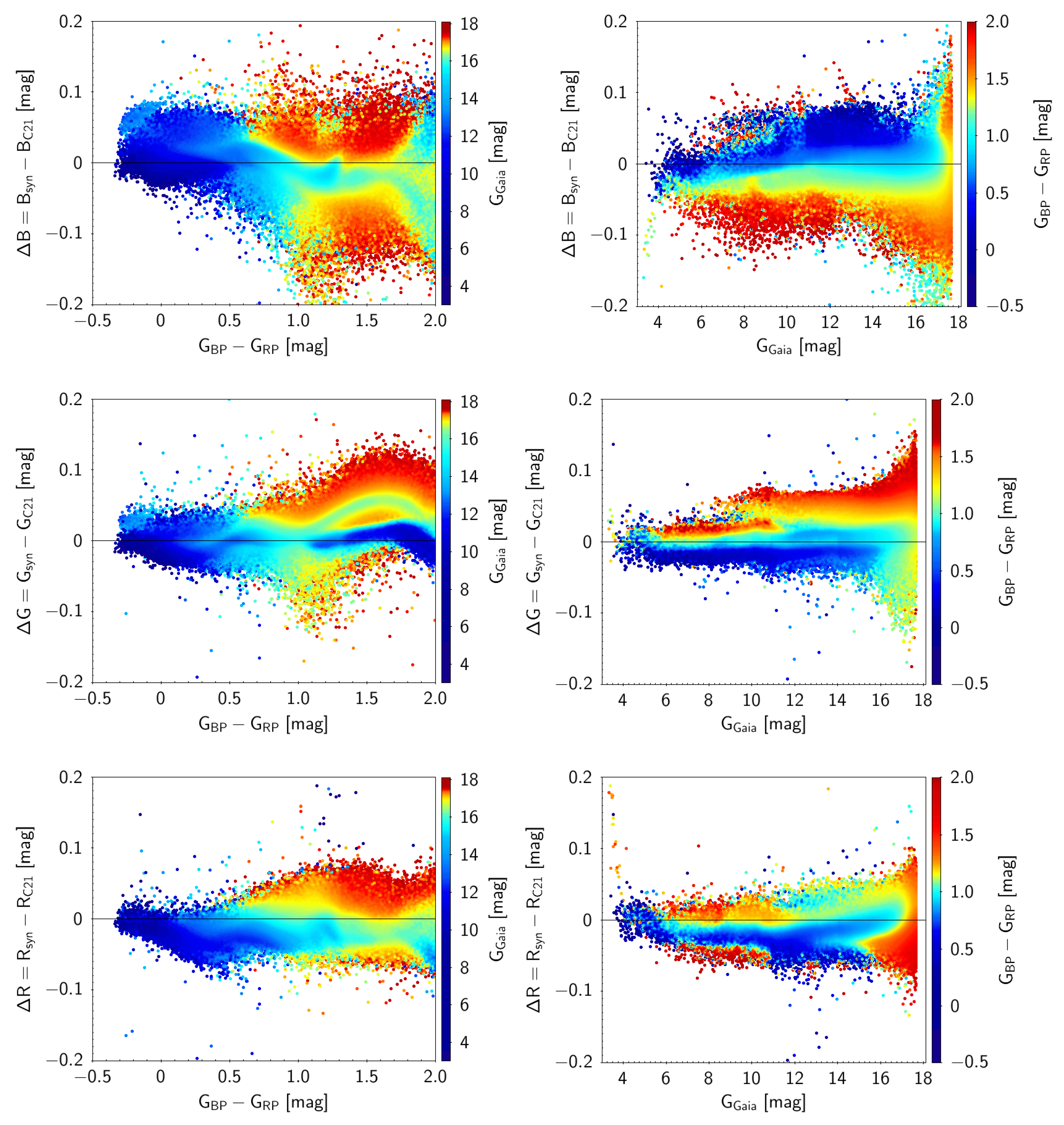
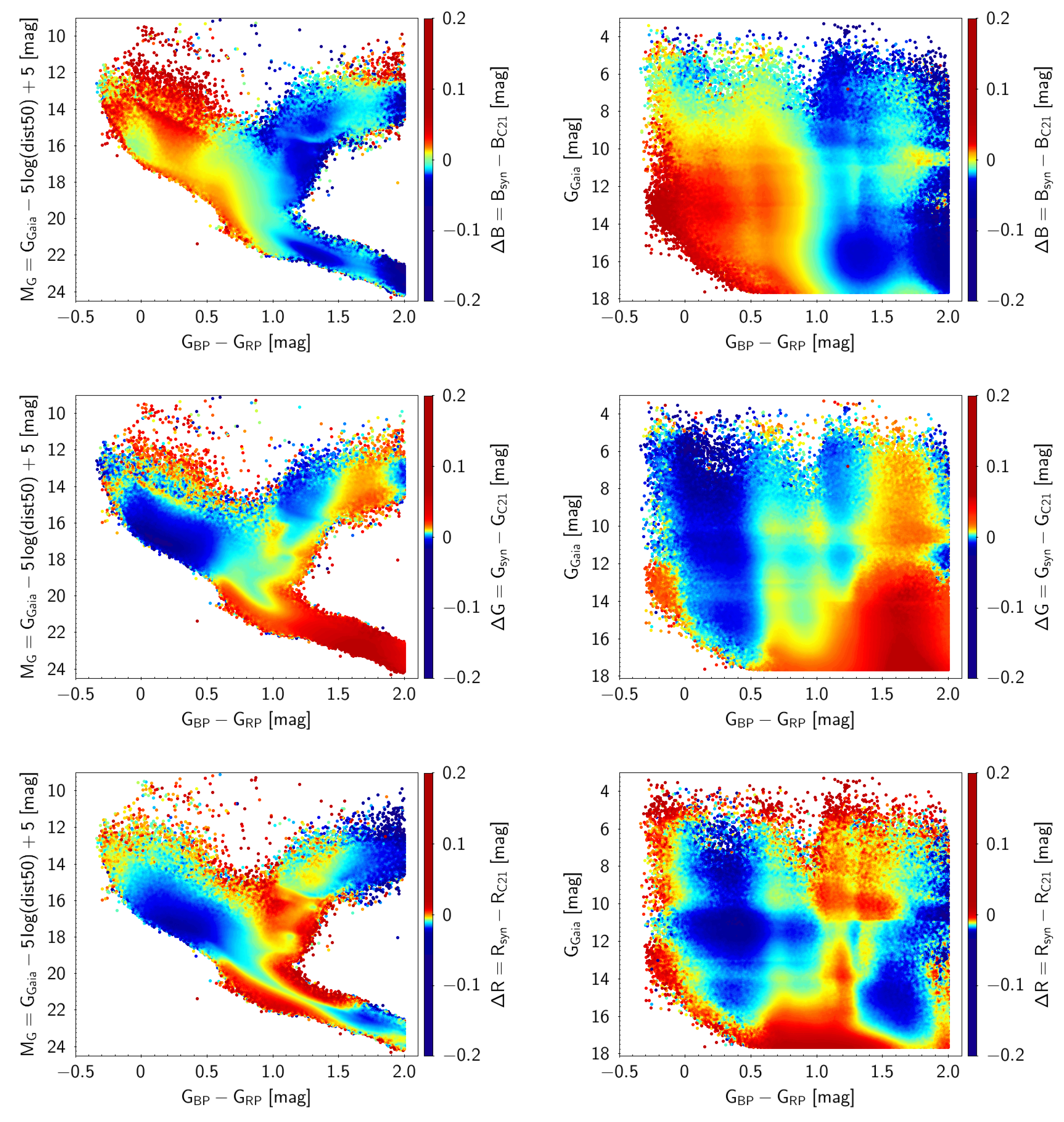
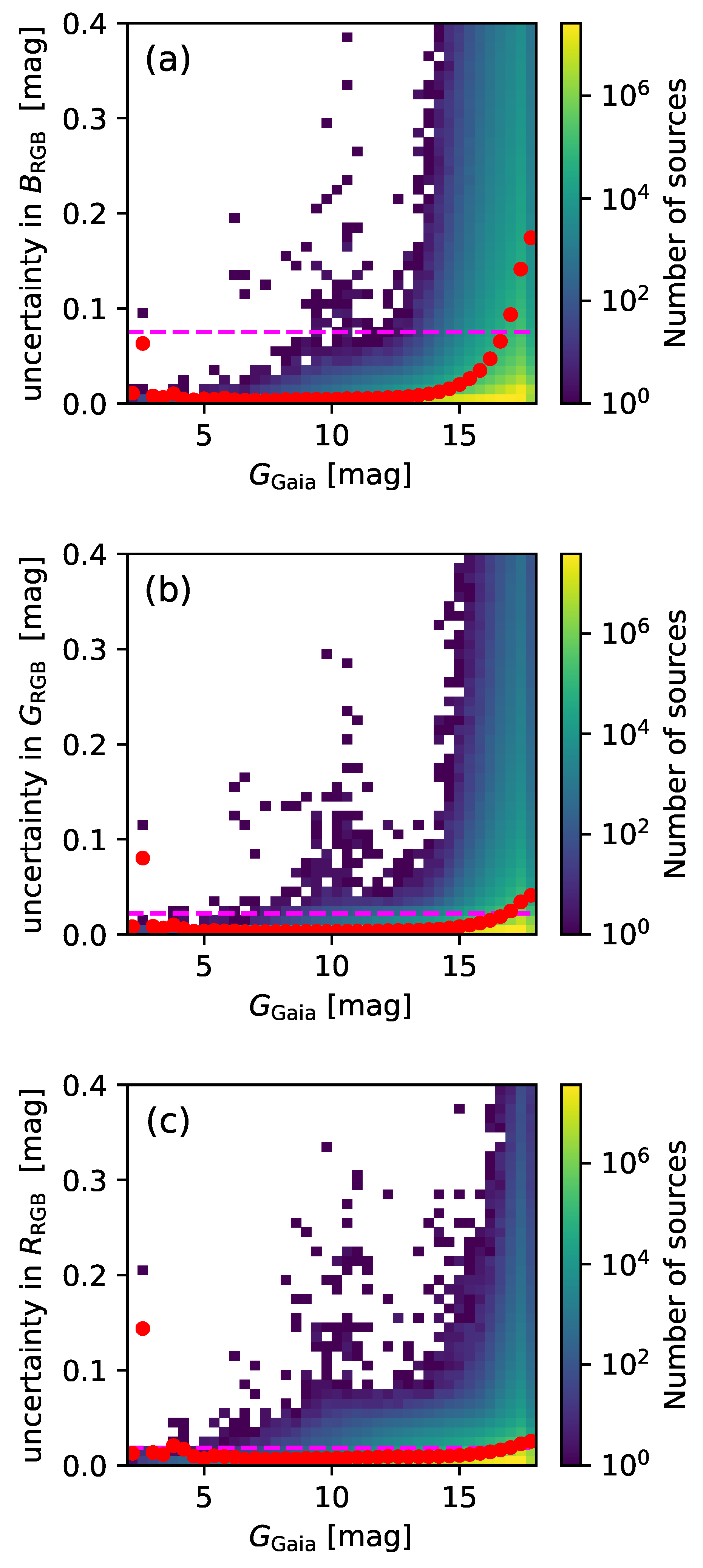
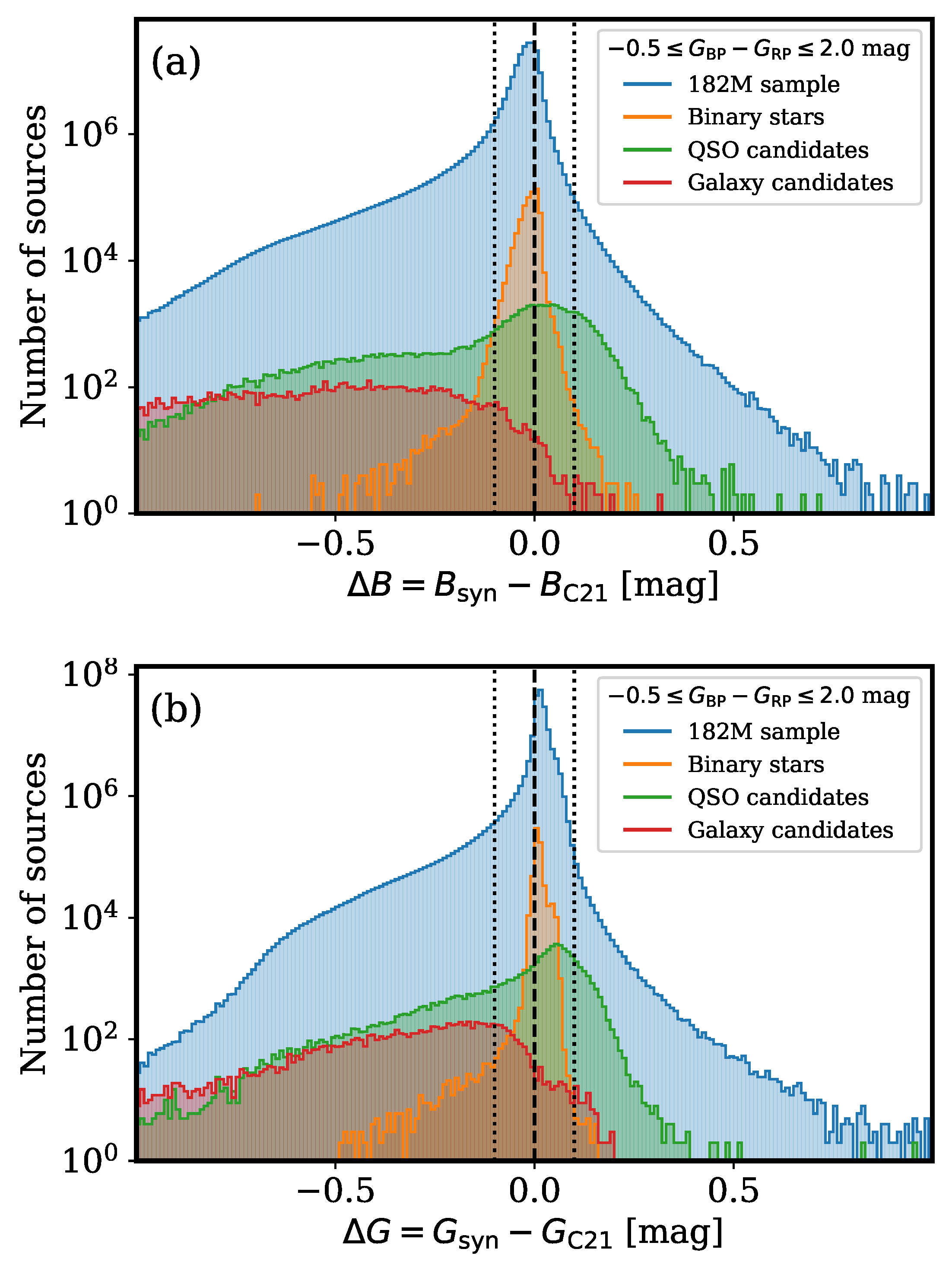
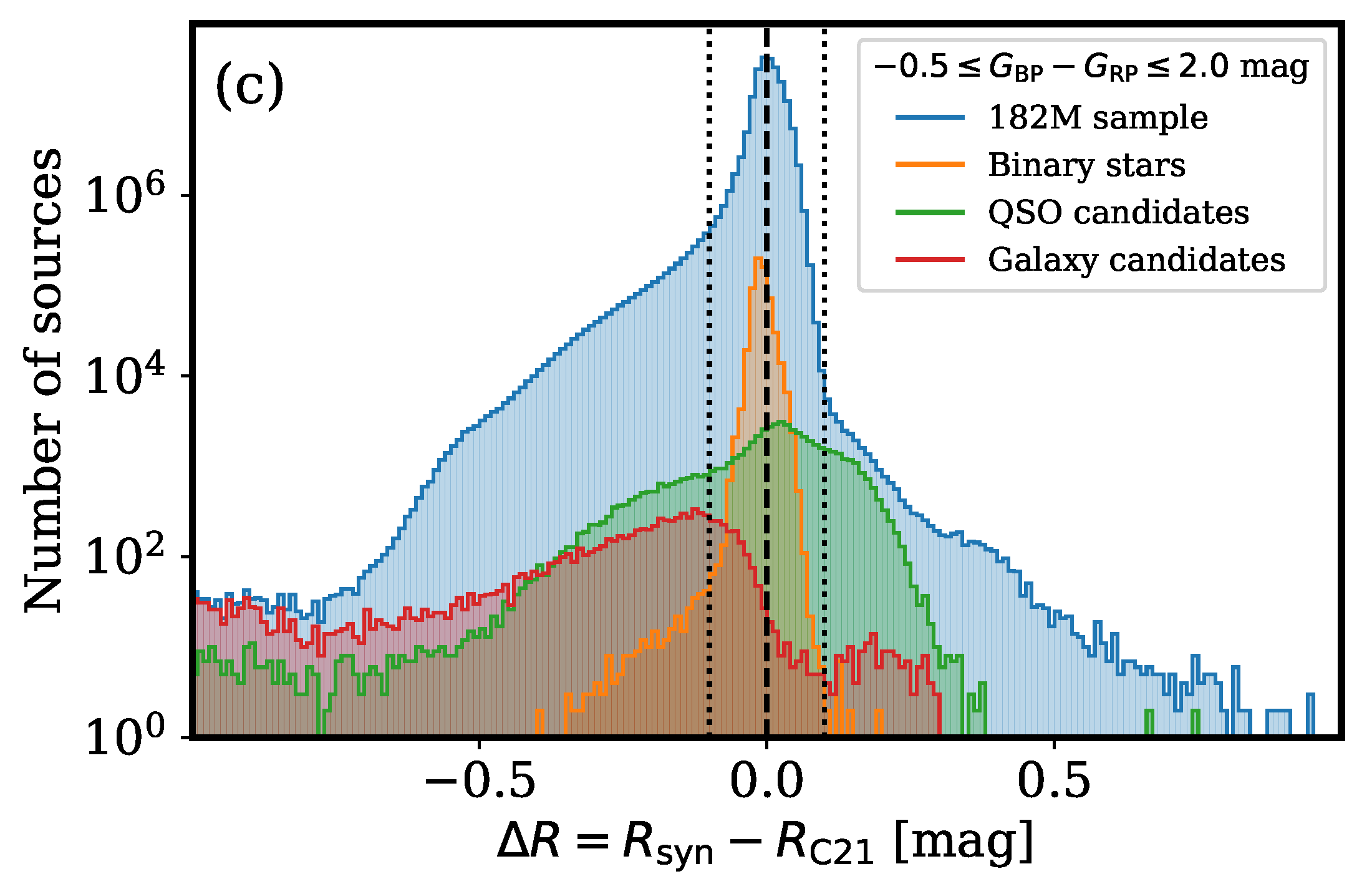
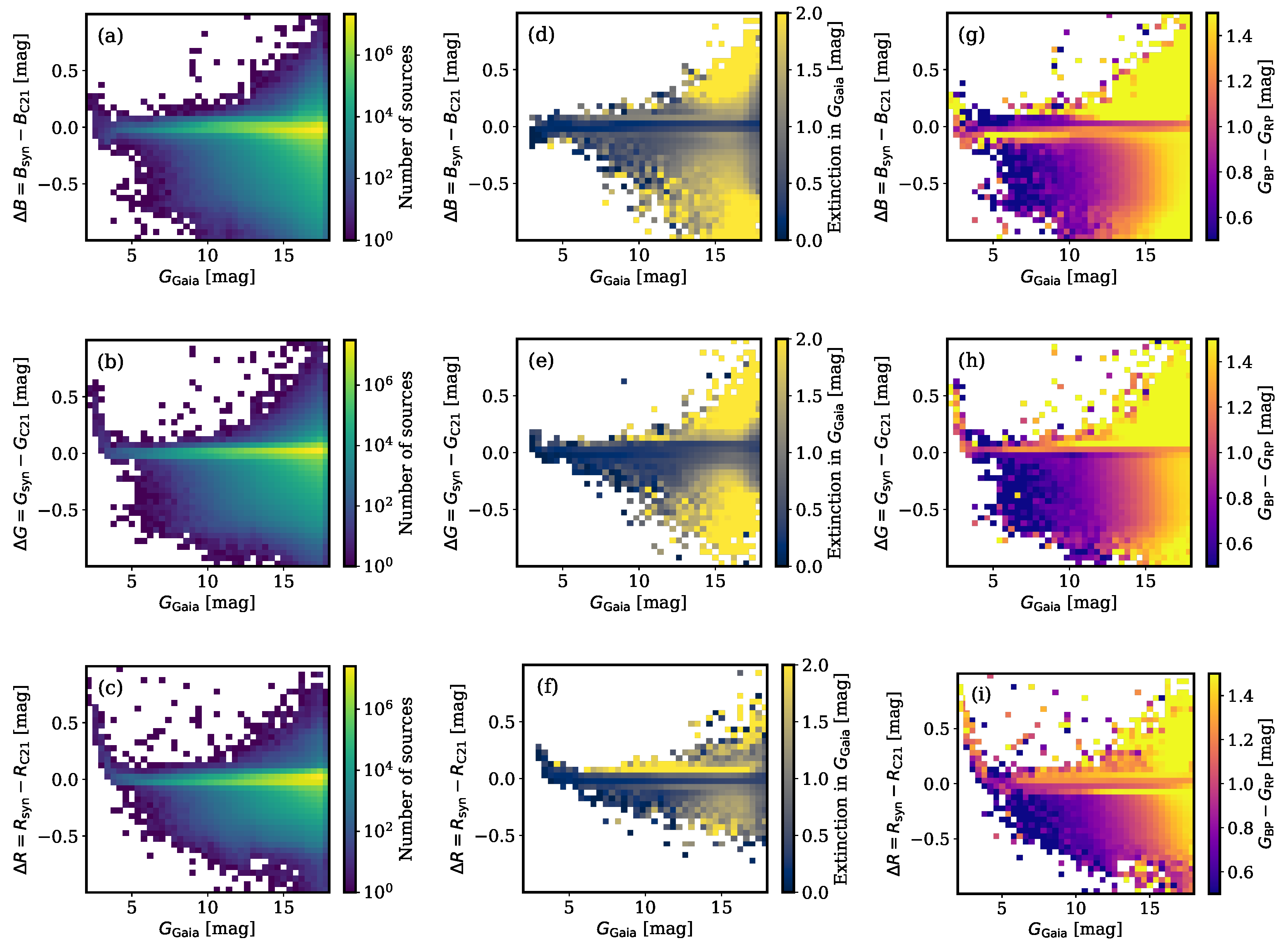
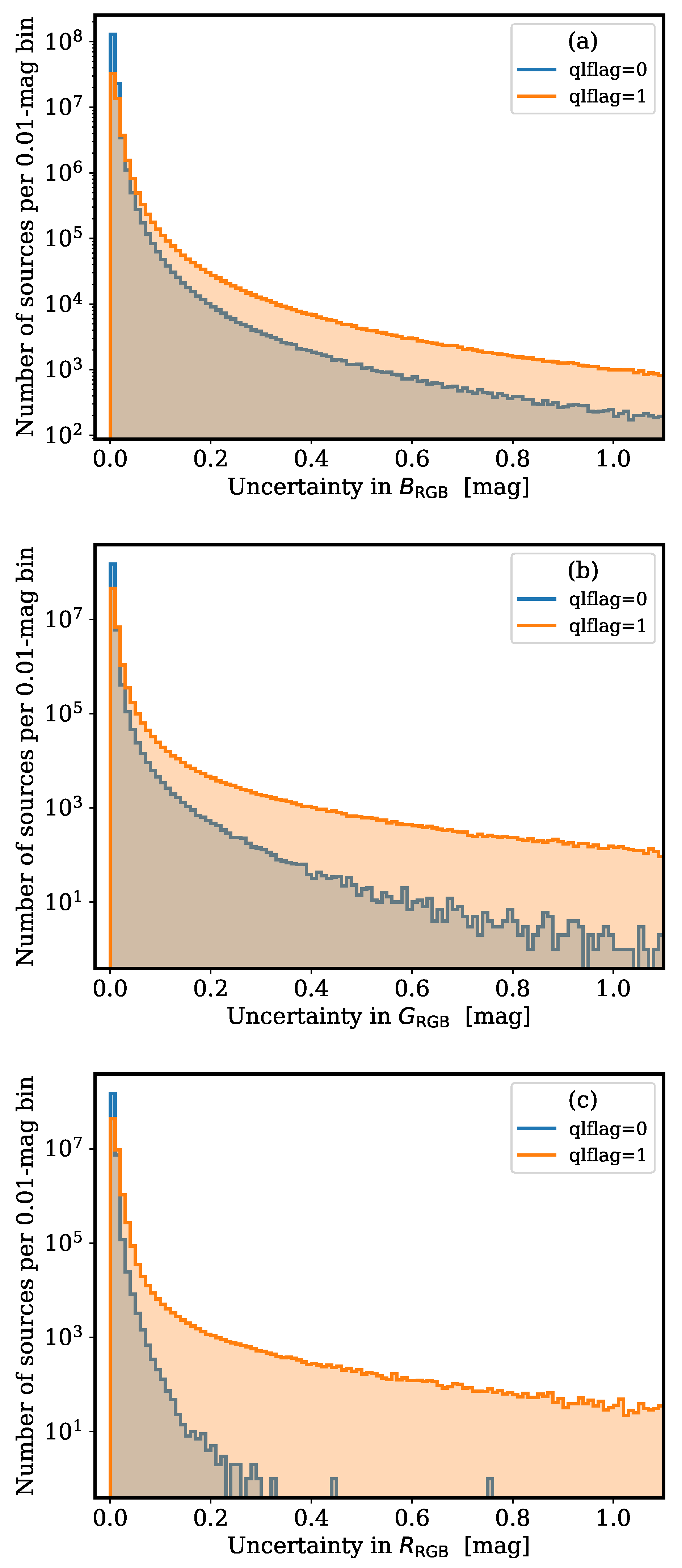
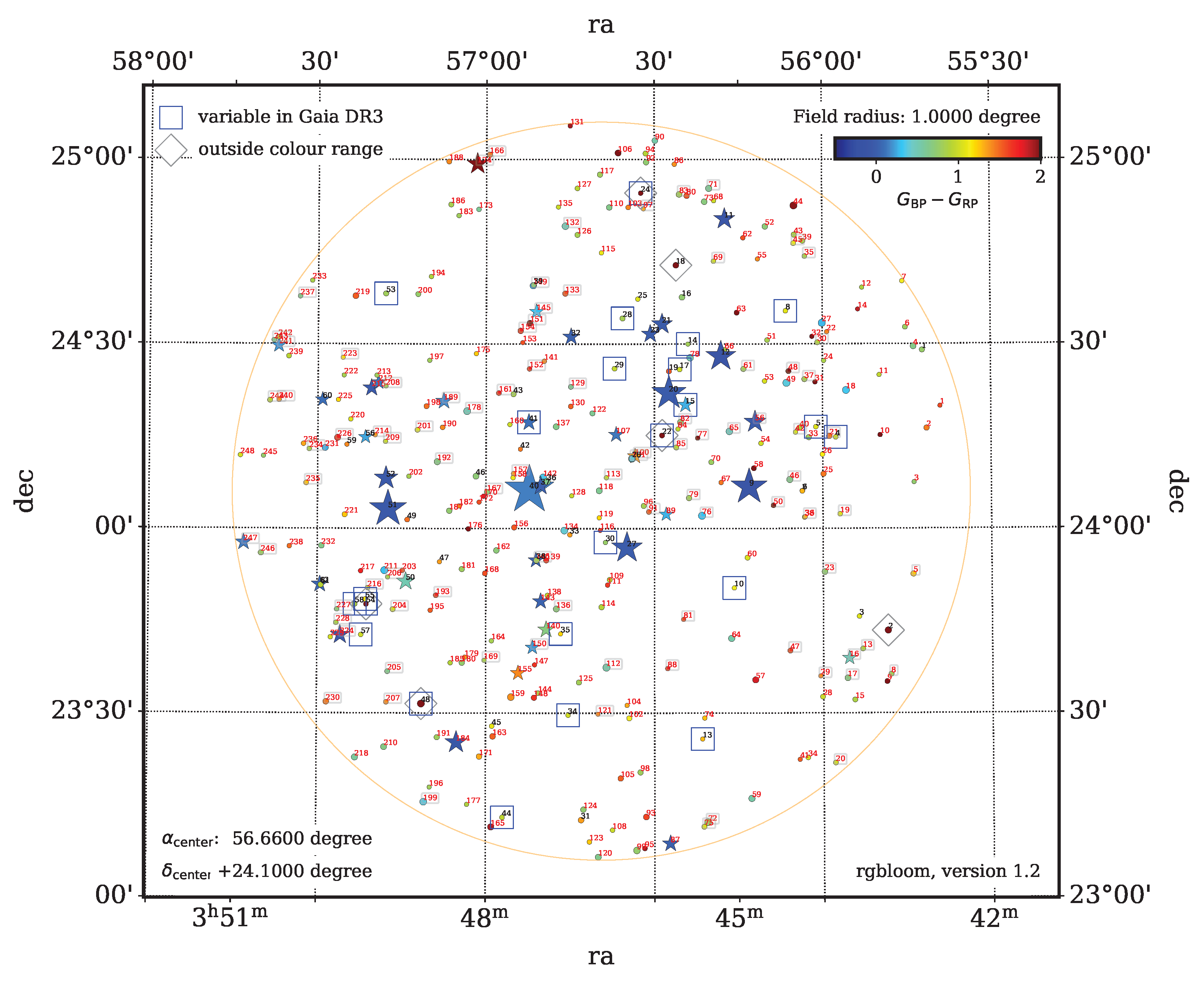
| Interval [mag] | Sources in C21 | Sources in 200 M |
|---|---|---|
| <10 | 133,019 | 299,041 |
| <11 | 344,349 | 775,526 |
| <12 | 761,279 | 1,948,176 |
| <13 | 1,431,314 | 4,636,535 |
| <14 | 2,484,448 | 10,495,506 |
| <15 | 3,977,325 | 22,967,532 |
| <16 | 6,546,925 | 48,355,681 |
| <17 | 10,346,030 | 97,464,183 |
| <18 | 13,820,929 | 182,081,668 |
| <19 | 14,854,959 | 209,094,405 |
| <20 | 14,854,959 | 212,129,751 |
| ≲21 | 14,854,959 | 213,064,002 |
| Source_id | objtype | qlflag | ||||||
|---|---|---|---|---|---|---|---|---|
| 4295806720 | 18.245 | 17.935 | 17.678 | 0.011 | 0.009 | 0.011 | 0 | 0 |
| 38655544960 | 15.003 | 14.570 | 14.171 | 0.003 | 0.002 | 0.002 | 0 | 0 |
| 1275606125952 | 16.849 | 16.519 | 16.266 | 0.005 | 0.004 | 0.006 | 0 | 0 |
| 1653563247744 | 16.544 | 16.336 | 16.196 | 0.005 | 0.004 | 0.005 | 0 | 0 |
| 2851858288640 | 12.779 | 12.550 | 12.387 | 0.001 | 0.001 | 0.002 | 0 | 0 |
| 3332894779520 | 13.335 | 12.894 | 12.539 | 0.002 | 0.001 | 0.002 | 0 | 0 |
| 3371550165888 | 15.314 | 14.938 | 14.615 | 0.003 | 0.002 | 0.003 | 0 | 1 |
| 3508989119232 | 15.736 | 15.431 | 15.199 | 0.003 | 0.003 | 0.003 | 0 | 0 |
| 4711579935744 | 14.736 | 14.481 | 14.300 | 0.002 | 0.002 | 0.003 | 0 | 0 |
| 4814659150336 | 18.490 | 17.854 | 17.297 | 0.013 | 0.009 | 0.009 | 0 | 1 |
| 5192616270720 | 18.370 | 17.551 | 16.964 | 0.013 | 0.007 | 0.007 | 0 | 0 |
| 5291399870976 | 17.301 | 17.033 | 16.842 | 0.006 | 0.005 | 0.007 | 0 | 0 |
| 5291399871488 | 18.935 | 18.296 | 17.686 | 0.019 | 0.012 | 0.011 | 0 | 0 |
| · | · | · | · | · | · | · | · | · |
| · | · | · | · | · | · | · | · | · |
| · | · | · | · | · | · | · | · | · |
Disclaimer/Publisher’s Note: The statements, opinions and data contained in all publications are solely those of the individual author(s) and contributor(s) and not of MDPI and/or the editor(s). MDPI and/or the editor(s) disclaim responsibility for any injury to people or property resulting from any ideas, methods, instructions or products referred to in the content. |
© 2023 by the authors. Licensee MDPI, Basel, Switzerland. This article is an open access article distributed under the terms and conditions of the Creative Commons Attribution (CC BY) license (https://creativecommons.org/licenses/by/4.0/).
Share and Cite
Carrasco, J.M.; Cardiel, N.; Masana, E.; Zamorano, J.; Pascual, S.; Sánchez de Miguel, A.; González, R.; Izquierdo, J. Photometric Catalogue for Space and Ground Night-Time Remote-Sensing Calibration: RGB Synthetic Photometry from Gaia DR3 Spectrophotometry. Remote Sens. 2023, 15, 1767. https://doi.org/10.3390/rs15071767
Carrasco JM, Cardiel N, Masana E, Zamorano J, Pascual S, Sánchez de Miguel A, González R, Izquierdo J. Photometric Catalogue for Space and Ground Night-Time Remote-Sensing Calibration: RGB Synthetic Photometry from Gaia DR3 Spectrophotometry. Remote Sensing. 2023; 15(7):1767. https://doi.org/10.3390/rs15071767
Chicago/Turabian StyleCarrasco, Josep Manel, Nicolas Cardiel, Eduard Masana, Jaime Zamorano, Sergio Pascual, Alejandro Sánchez de Miguel, Rafael González, and Jaime Izquierdo. 2023. "Photometric Catalogue for Space and Ground Night-Time Remote-Sensing Calibration: RGB Synthetic Photometry from Gaia DR3 Spectrophotometry" Remote Sensing 15, no. 7: 1767. https://doi.org/10.3390/rs15071767
APA StyleCarrasco, J. M., Cardiel, N., Masana, E., Zamorano, J., Pascual, S., Sánchez de Miguel, A., González, R., & Izquierdo, J. (2023). Photometric Catalogue for Space and Ground Night-Time Remote-Sensing Calibration: RGB Synthetic Photometry from Gaia DR3 Spectrophotometry. Remote Sensing, 15(7), 1767. https://doi.org/10.3390/rs15071767






